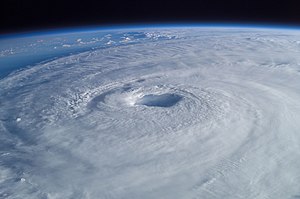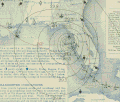Portal:Tropical cyclones
The Tropical Cyclones Portal

A tropical cyclone is a storm system characterized by a large low-pressure center, a closed low-level circulation and a spiral arrangement of numerous thunderstorms that produce strong winds and heavy rainfall. Tropical cyclones feed on the heat released when moist air rises, resulting in condensation of water vapor contained in the moist air. They are fueled by a different heat mechanism than other cyclonic windstorms such as Nor'easters, European windstorms and polar lows, leading to their classification as "warm core" storm systems. Most tropical cyclones originate in the doldrums, approximately ten degrees from the Equator.
The term "tropical" refers to both the geographic origin of these systems, which form almost exclusively in tropical regions of the globe, as well as to their formation in maritime tropical air masses. The term "cyclone" refers to such storms' cyclonic nature, with anticlockwise rotation in the Northern Hemisphere and clockwise rotation in the Southern Hemisphere. Depending on its location and intensity, a tropical cyclone may be referred to by names such as "hurricane", "typhoon", "tropical storm", "cyclonic storm", "tropical depression" or simply "cyclone".
Types of cyclone: 1. A "Typhoon" is a tropical cyclone located in the North-west Pacific Ocean which has the most cyclonic activity and storms occur year-round. 2. A "Hurricane" is also a tropical cyclone located at the North Atlantic Ocean or North-east Pacific Ocean which have an average storm activity and storms typically form between May 15 and November 30. 3. A "Cyclone" is a tropical cyclone that occurs in the South Pacific and Indian Oceans.
Selected named cyclone -
Hurricane Pali was the earliest-forming Pacific hurricane on record, being the first Pacific hurricane to occur in January since Hurricane Ekeka of 1992. The first tropical cyclone of the 2016 Pacific hurricane season, Pali originated as an area of low pressure within a persistent trough, near the equator on January 6, 2016. Deep convection gradually built up around the center of the disturbance as the system curved northward, before it organized into a tropical depression on the next day, making the system the earliest recorded tropical cyclone in the Pacific hurricane basin. The system quickly intensified into a tropical storm, resulting in it being named Pali. During the next few days, Pali slowly moved northward while slowly curving towards the west, strengthening somewhat before weakening due to the presence of wind shear. On January 10, Pali slowly turned eastward and proceeded to re-strengthen as wind shear diminished.
On January 12, Pali strengthened into a Category 1 hurricane on the Saffir–Simpson scale (SSWHS) while curving towards the south. The next day, Pali reached its peak intensity as a Category 2 hurricane, with 1-minute maximum sustained winds of 100 mph (155 km/h) and a minimum central pressure of 978 mbar (hPa; 28.88 inHg). Afterward, Pali quickly began to weaken, as the storm encountered stronger wind shear, with the storm weakening into a Category 1 hurricane several hours later, before weakening into a tropical storm later that day. On January 14, Pali weakened into a tropical depression before degenerating into a remnant low the next day, since conditions became increasingly hostile. Later that day, Pali's remnants dissipated near the same location where they had formed roughly a week ago. Pali formed and tracked near the equator, forming at a latitude of 3.3°N and tracking as low as 2.6°N as a tropical depression. This made Pali the second-lowest latitude tropical cyclone on record in the Western Hemisphere at the time, which was extremely unusual, given the unfavorable conditions that are usually in place around the equator. (Full article...)Selected article -

Selected image -

Selected season -

The 2020 Atlantic hurricane season is the most active Atlantic hurricane season on record, in terms of number of systems. It featured a total of 31 tropical or subtropical cyclones, with all but one cyclone becoming a named storm. Of the 30 named storms, 14 developed into hurricanes, and a record-tying seven further intensified into major hurricanes. It was the second and final season to use the Greek letter storm naming system, the first being 2005, the previous record. Of the 30 named storms, 11 of them made landfall in the contiguous United States, breaking the record of nine set in 1916. During the season, 27 tropical storms established a new record for earliest formation date by storm number. This season also featured a record ten tropical cyclones that underwent rapid intensification, tying it with 1995, as well as tying the record for most Category 4 hurricanes in a singular season in the Atlantic Basin. This unprecedented activity was fueled by a La Niña that developed in the summer months of 2020, continuing a stretch of above-average seasonal activity that began in 2016. Despite the record-high activity, this was the first season since 2015 in which no Category 5 hurricanes formed.
The season officially started on June 1 and officially ended on November 30. However, tropical cyclogenesis is possible at any time of the year, as demonstrated by the early formation of Tropical Storms Arthur and Bertha, on May 16 and 27, respectively. This was the sixth consecutive year with a pre-season system and the second of these seasons to have two, with the other being 2016. The first hurricane, Hurricane Hanna, made landfall in Texas on July 25. Hurricane Isaias formed on July 31, and made landfall in The Bahamas and North Carolina in early August, both times as a Category 1 hurricane; Isaias caused $4.8 billion in damage overall. In late August, Laura made landfall in Louisiana as a Category 4 hurricane, becoming the strongest tropical cyclone on record in terms of wind speed to make landfall in the state, alongside the 1856 Last Island hurricane and Ida. Laura caused at least $19 billion in damage and 77 deaths. September was the most active month on record in the Atlantic, with ten named storms. Slow-moving Hurricane Sally impacted the United States Gulf Coast, causing severe flooding. The Greek alphabet was used for only the second time, starting on September 17 with Subtropical Storm Alpha, which made landfall in Portugal on the following day. (Full article...)Related portals
Currently active tropical cyclones

Italicized basins are unofficial.
- North Atlantic (2024)
- No active systems
- North Indian Ocean (2024)
- No active systems
- Mediterranean (2024–25)
- No active systems
- South-West Indian Ocean (2024–25)
- No active systems
- Australian region (2024–25)
- No active systems
- South Pacific (2024–25)
- No active systems
- South Atlantic (2024–25)
- No active systems
Last updated: 20:45, 25 August 2024 (UTC)
Tropical cyclone anniversaries

August 25
- 1873 - The 1873 Nova Scotia hurricane moved away from the Nova Scotia coast towards Newfoundland, after killing about 500 people and causing $5.9 million of damage.
- 2017 - Hurricane Harvey (pictured) reached its peak strength as a Category 4 hurricane, shortly before making landfall over Texas, which killed 106 people in the US and caused around $125 billion (2017 USD) in damages, making Harvey the second-costliest tropical cyclone worldwide.

August 26
- 1931 - After a typhoon moved ashore China near Ningbo, heavy rainfall caused portions of the Grand Canal to collapse, leaving to a wall of water that killed 300,000 people during the country's worst floods on record.
- 2004 - Typhoon Aere made landfall near Xiamen as a weakening Category 1 typhoon. Overall, Aere killed a total of 107 people.
- 2011 - Typhoon Nanmadol (pictured) reached Category 5 super typhoon intensity as it made landfall over Gonzaga, Cagayan. In the Philippines, 38 people were killed by the storm, including $34.5 million in damages.

August 27,
- 1893 - The 1893 Sea Islands hurricane (track pictured) made landfall near Savannah, Georgia with winds of about 220 km/h (120 mph). The hurricane killed between 1,000 and 2,000 people on the Sea Islands off the Georgian and South Carolinan coastlines.
- 1989 - Hurricane Kiko (pictured) reaches peak intensity as a Category 3 hurricane with winds of 195 km/h (120 mph). In the same time, Kiko made landfall over in the southern tip of Baja California, though no fatalities and damages were reported.
Did you know…




- …that the Joint Typhoon Warning Center considers that Typhoon Vera (pictured) of 1986 is actually two distinct systems, formed from two separated low-level circulations?
- …that Cyclone Freddy (track pictured) in 2023 was the longest-lasting tropical cyclone worldwide?
- …that Cyclone Raquel (track pictured) travelled between the Australian and South Pacific basins between the 2014–15 and 2015–16 seasons, spanning both seasons in both basins?
- …that Hurricane Otis (pictured) in 2023 was the first Pacific hurricane to make landfall at Category 5 intensity and surpassed Hurricane Patricia as the strongest landfalling Pacific hurricane on record?
General images -

Arizona has been affected by hurricanes on numerous occasions. Usually, these storms originate in the eastern Pacific Ocean, make landfall in the Mexican states of Baja California or Sonora, and dissipate before crossing into the United States. Thus, in most cases, it is only the tropical cyclones' remnant moisture that produces heavy rainfall—and in some occasions, flooding—in portions of Arizona. However, approximately every five years, a tropical cyclone retains sufficient strength to enter the state as a tropical storm or a tropical depression. Arizonans can expect indirect flash floods caused by the remnants of tropical cyclones to occur about every two years.
Tropical cyclones in Arizona are not common, since the predominant wind pattern steers most storms that form in the Eastern Pacific either parallel or away from the Pacific coast of northwestern Mexico. As a result, most storms that could affect Arizona are carried away from the United States, with only 6% of all Pacific hurricanes entering US territory. Not all Arizona hurricanes originate from the Pacific Ocean, however; in July 2008 an Atlantic hurricane named Hurricane Dolly produced rainfall in the eastern portion of the state, and another Atlantic storm reached Arizona as a tropical depression. Many, but not all, of these systems also impacted California. (Full article...)Topics
Subcategories
Related WikiProjects
WikiProject Tropical cyclones is the central point of coordination for Wikipedia's coverage of tropical cyclones. Feel free to help!
WikiProject Weather is the main center point of coordination for Wikipedia's coverage of meteorology in general, and the parent project of WikiProject Tropical cyclones. Three other branches of WikiProject Weather in particular share significant overlaps with WikiProject Tropical cyclones:
- The Non-tropical storms task force coordinates most of Wikipedia's coverage on extratropical cyclones, which tropical cyclones often transition into near the end of their lifespan.
- The Floods task force takes on the scope of flooding events all over the world, with rainfall from tropical cyclones a significant factor in many of them.
- WikiProject Severe weather documents the effects of extreme weather such as tornadoes, which landfalling tropical cyclones can produce.
Things you can do
 |
Here are some tasks awaiting attention:
|
Wikimedia
The following Wikimedia Foundation sister projects provide more on this subject:
-
Commons
Free media repository -
Wikibooks
Free textbooks and manuals -
Wikidata
Free knowledge base -
Wikinews
Free-content news -
Wikiquote
Collection of quotations -
Wikisource
Free-content library -
Wikiversity
Free learning tools -
Wikivoyage
Free travel guide -
Wiktionary
Dictionary and thesaurus
























































